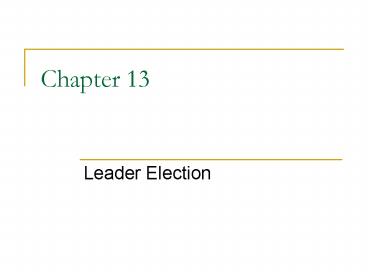Leader Election PowerPoint PPT Presentation
1 / 15
Title: Leader Election
1
Chapter 13
- Leader Election
2
Leader Election
- Breaking the symmetry in system
- Similar to distributed mutual exclusion problems,
the first process to enter the CS can be the
leader - Lamports algorithm is not efficient for leader
election in a ring
3
Ring based leader election
- No deterministic algorithm for leader election in
an anonymous ring - Initial state is completely symmetric
- All processes take the same action
- The new state is also symmetric
- This can be repeated forever
4
Chang-Roberts algorithm
- Every process sends an election message with its
id to the left process if it has not seen a
message from a higher process - Forward any message with an id greater than own
id to the left - If a process receives its own election message it
is the leader - It then declares itself to be the leader by
sending a leader message
5
//Chang-Roberts Leader Election public class
RingLeader extends Process implements Election
int number int leaderId -1 int
next boolean awake false public
synchronized int getLeader() while
(leaderId -1) myWait() return
leaderId public synchronized void
handleMsg(Msg m, int src, String tag)
int j m.getMessageInt() // get the number
if (tag.equals("election")) if
(j gt number) sendMsg(next,
"election", j) // forward the message
else if (j number) // I won!
sendMsg(next, "leader", myId) else
if ((j lt number) !awake) startElection()
else if (tag.equals("leader"))
leaderId j notify()
if (j ! myId) sendMsg(next, "leader", j)
public synchronized void
startElection() awake true
sendMsg(next, "election", number)
6
Chang Roberts Leader Election
- Worst case message complexity
Best case
Worst case
7
Hirschberg-Sinclair algorithm
- Assume ring is bidirectional
- Carry out elections on increasingly larger sets
- Algorithm works in asynchronous rounds
- Only processes that win the election in round r
can proceed to round r1 - Algorithm Pi is the leader in round r iff it has
the largest id of all nodes that are at a
distance 2r or less from Pi
8
Hirschberg-Sinclair algorithm
- Initially
- All processes are leaders
- Round 0
- 6 , 7 and 8 are leaders
- Round 1
- 7, 8 are leaders
- Round 2
- 8 is the only leader
- At most log(N) rounds
9
Election on general graphs
- Totally connected graph use Lamports mutex
algorithm - If the graph is not completely connected
- Construct a spanning tree
10
Spanning tree construction
- Assume a distinguished process root (we will
remove this assumption later) - root initiates the algorithm by sending an invite
to all neighbors - When Pi receives an invite for the first time,
(say from Pj) it sends the invite to all
processes except Pj and sends accept to Pj (i.e.
Pj is now the parent of Pi) - Pi replies with a reject to all invites received
later - All processes maintain the of nodes from which
they have received messages
11
public class SpanTree extends Process
public int parent -1 // no parent yet
public IntLinkedList children new
IntLinkedList() int numReports 0
boolean done false public SpanTree(Linker
initComm, boolean isRoot) if (isRoot)
parent myId if
(initComm.neighbors.size() 0)
done true else
sendToNeighbors( "invite", myId)
. . . public synchronized void
handleMsg(Message m, int source, String tag)
if (tag.equals("invite")) if
(parent -1) numReports
parent source
sendMsg(source, "accept") for (int i
0 i lt N i) if ((i !
myId) (i ! source) isNeighbor(i))
sendMsg(i, "invite")
else sendMsg(source,
"reject") else if ((tag.equals("accept"
)) (tag.equals("reject"))) if
(tag.equals("accept")) children.add(source)
numReports if (numReports
comm.neighbors.size()) done
true notify()
12
Spanning tree
- This algorithm can be also used for broadcast by
flooding when there is no predefined spanning
tree - If there is no distinguished process
- each process can start the spanning tree
construction - All messages in the spanning tree started by Pi
contain the id of Pi - Only the instance started by the largest process
succeeds
13
Application Computing global functions
- If we have variable xi at process Pi
- Compute a function f(x1,x2,x3 ,,xn)
- Assume we have a predefined spanning tree and use
convergecast and broadcast to compute the global
function
14
Convergecast
Broadcast
15
Computing a global function
- Assume the global function is commutative and
associative - Eg. min, max, sum, product
- Each node of the tree computes the function using
its value and the values received from its
children - This partial answer is sent to the parent
- When the root computes the final value, it
broadcasts the answer

